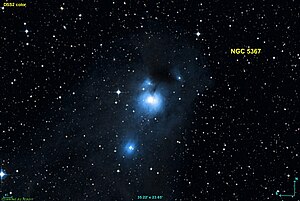NGC 5367
aus Wikipedia, der freien Enzyklopädie
| Reflexionsnebel | |
|---|---|
| NGC 5367 | |

| |
| Sternbild | Zentaur |
| Position Äquinoktium: J2000.0 | |
| Rektaszension | 13h 57m 43,8s [1] |
| Deklination | -39° 58′ 42″ [1] |
| Weitere Daten | |
| Winkelausdehnung |
1' × 1' [2] |
| Geschichte | |
| Entdeckung |
John Herschel |
| Datum der Entdeckung |
26. Juni 1834 |
| Katalogbezeichnungen | |
| NGC 5367 • IC 4347 • GC 3706, h 3548, ESO 325-N*36 | |
| AladinLite | |
NGC 5367 ist ein Reflexionsnebel im Sternbild Zentaur. Er wurde am 26. Juni 1834 von John Herschel mit einem 18-Zoll-Spiegelteleskop entdeckt,[3] der bei mehreren Beobachtungen notierte[4]:
- „a close double star in a very large, bright, luminous atmosphere, 2′ diameter. The star A which is quite as bright, has no such atmosphere. The atmosphere is very little brighter in the middle. The star was not noticed as double till too late for a good measure after I showed the object to my attendant J.S., verified with 240x and 320x. A furious hot north wind, but the definition of stars excellent. It is no illusion, other stars are sharp and brilliant, and have not the least nebulous appearance“
- „double star h 4636 involved in nebulosity“
- „the nebulosity is very evident ... neb at least 2′ or 2.5′ diameter“
- „very faint, 2′ diameter, and star of 9th mag following, is about 4′ distant, is unaffected with nebulosity“.
In seinen Notizen ist zu finden:
- „[NGC 5367 and NGC 1847] are nebulae, centrally involving double stars. Central superposition must undoubtedly be held strong presumptive evidence of physical connexion“.
Lewis A. Swift beobachtete am 30. Dezember 1897 ebenfalls diesen Nebel, dies fand als IC 4347 einen Eintrag in den Index-Katalog.
Weblinks
- NGC 5367. SIMBAD, abgerufen am 21. Februar 2015 (englisch).
- NGC 5367. DSO Browser, abgerufen am 21. Februar 2015 (englisch).
- Spektrum.de: Amateuraufnahmen [1]